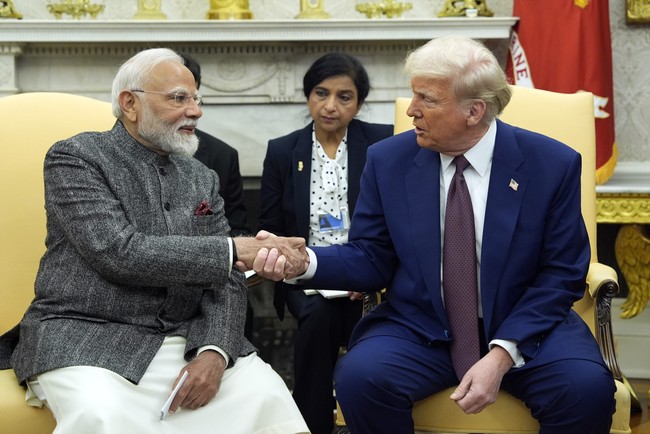
I hate to say I told you so, but … naah, I love to say I told you so.
When Donald Trump announced the trade deal with the EU and Ursala von der Leyen, most of the focus fell on the economic victory it created. Most overlooked its strategic importance in cutting off energy sales to Russia in the commitment to buy $750 billion in LNG. Putin deputy Dmitry Medvedec did not, however, complaining that it was “anti-Russian” and an escalation in tensions between the US and Russia.
At the same time, Trump had accelerated his timeline for Russia to negotiate an end to the war in Ukraine in good faith. Medvedev rejected that as well, but Trump meant business — and now India knows it, as I predicted. With a healthy economy at his back and the EU buying energy from the West rather than the East, Trump is now forcing Narendra Modi to choose between cheap Russian oil or the lucrative US consumer-goods market:
President Trump is applying fresh pressure to U.S. trading partners, singling out India for its links to Moscow.
In a social-media post early Wednesday, Trump said goods from India would face 25% tariffs, and the country would also be penalized for buying Russian arms and energy. The Indian rupee sank against the dollar.
Also, they have always bought a vast majority of their military equipment from Russia, and are Russia’s largest buyer of ENERGY, along with China, at a time when everyone wants Russia to STOP THE KILLING IN UKRAINE — ALL THINGS NOT GOOD! INDIA WILL THEREFORE BE PAYING A TARIFF OF 25%, PLUS A PENALTY FOR THE ABOVE, STARTING ON AUGUST FIRST. THANK YOU FOR YOUR ATTENTION TO THIS MATTER. MAGA!
Two days ago, I predicted that Trump’s next step would be to force India to make this exact choice. Trump has already threatened to hike tariffs on Russia, but we have very little trade with Russia already, thanks to sanctions (that Trump will also intensify). The pressure point will be on Russia’s major trading partners, and the most obvious and convertible is Modi:
The US has largely ignored Russia’s trade with our trading partners, aside from some nominal sanctions on energy. If Trump gets serious about this, though, India risks losing access to American markets that, needless to say, are far more lucrative than Russia. The US would likely have to increase energy sales to India to make up any potential loss, just as Trump did with the EU in the trade agreement this weekend.
That’s no small amount of oil to replace, either. Russia accounts for around 4-5% of the oil supply in global markets, and the two biggest purchasers are India and China. Trump will have to get other producers to make up any deficits. The best prospect would be Saudi Arabia, but the US could accelerate its production to bolster supplies on the global markets as well, and that would be a good strategy anyway to keep Putin from profiting off his exports. The rumored 100% tariff level for Russia’s customers would all but end their access to American markets, even the low-cost goods produced in India for mass consumption in the US.
Hence, the Hobson’s choice now faces Modi. India exported nearly $80 billion to the US in 2024, a not-insubstantial number even with a GDP in the same year of $4.19 trillion. That puts India as the fourth-largest economy by GDP (projected 5th in 2025), but waaaaaay down the rankings in per-capita GDP, which doesn’t even get to $3,000. Modi needs far more growth to combat massive poverty in his country, and the US and EU are going to be far better partners for that strategy than Russia or China. If Modi can get cheap energy from other sources while keeping access to US markets, the choice becomes much easier to make.
This is at least one reason why Trump has pushed hard for a broad tariff strategy. He believes in it as an economic policy, of course, but it opens up strategic options that don’t otherwise exist. He can use American economic muscle rather than more provocative military strength to isolate bad actors, along with the credibility of enforcement that Trump has already demonstrated. Access to American consumers is a big f’in deal, as Joe Biden once said in a different context, and world leaders know it — especially those struggling with massive poverty and in dire need of expansion of exports in both goods and services to the US.
Trump knows leverage when he sees it. Modi had better see it, too.
Editor’s Note: Thanks to President Trump and his administration’s bold leadership, we are respected on the world stage, and our enemies are being put on notice.
Help us continue to report on the administration’s peace through strength foreign policy and its successes. Join Hot Air VIP and use promo code FIGHT to get 60% off your VIP membership.












